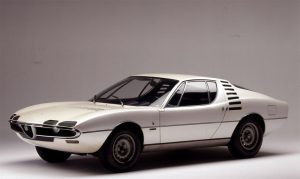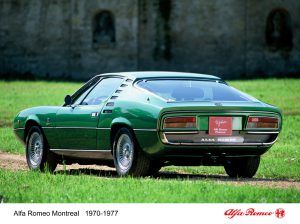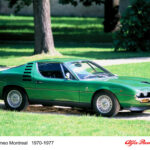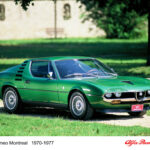AUTOMOBILE CULTURE: Show car shown at the 1967 World’s Fair in Canada forms the basis for one of the coolest coupés of the 1970s.
Show car shown at the 1967 World’s Fair in Canada forms the basis for one of the coolest coupés of the 1970s. Bertone designer Marcello Gandini created a compact body with details that are legendary today, such as double headlights behind slatted covers and suggested air intakes behind the doors. 147 kW (200 hp) V8 engine derives from the racing power unit of the Alfa Romeo Tipo 33 super sports car.
Frankfurt, March 2020
The call from Montreal comes as a surprise to the Alfa Romeo management. In keeping with the future-oriented interpretation of the Expo, the organisers of the 1967 World’s Fair in the Canadian city want to highlight the theme “Man and his World” in a wide variety of areas. One of them is dedicated to industrially manufactured products, including the automobile, under the title “Man the Producer”. The organisers invite Alfa Romeo to provide an appropriately impressive concept car, representing the entire industry.
Alfa Romeo commissions the Bertone design studio to implement this theme. Marcello Gandini’s star is rising at the renowned carrozzeria. The Turin native was not yet 30 years old at the time, but had just caused a worldwide sensation with the Lamborghini Miura and would later draw other pioneering cars such as the Lancia Stratos and Fiat 132. Gandini designed a breathtaking coupé body with unique details for Alfa Romeo’s 1967 Expo show car. These include the B-/C-pillar, which visually merged into one unit, and the double headlights half-covered by a louvred grille.
At just 4.22 metres long, the car is extremely compact, with just enough room for two spare seats behind the driver and front passenger. Striking air intakes behind the doors and a large, glass tailgate hint at the drive concept Gandini has in mind: a mid-engine. But it is not that far yet. Due to time constraints, Alfa Romeo uses the Giulia model’s floor assembly, including the engine placed at the front, for the two show cars* finally sent to Canada. This means that the show cars are at least rollable and even drivable.
On the Montreal Expo site, the concept cars are placed between mirrors in such a way that they appear to be multiplied to infinity. The reaction of the up to 500,000 visitors to the world exhibition every day is overwhelming. So the initially nameless, white-painted prototypes are given the unofficial name Montreal. And with every day of the six-month exhibition, Alfa Romeo receives more requests from North America and the rest of the world to develop the Expo eye-catcher to production readiness.
In fact, the development department is given the task of putting the “Montreal” project into practice. With an eye on production costs, the engineers work out a compromise. The chassis remains largely the same as the proven Alfa Romeo Giulia. Marcello Gandini’s spectacular body design is also only changed in those details where the concept car is not compatible with the requirements of series production or road registration. For example, the – slightly modified – grille above the headlights is retained in principle. When the lights are switched on, however, the two slats are mechanically folded down to reveal the four lamps completely. The air vents in the flanks, intended by designer Gandini for a mid-engine design, are retained, but now serve to ventilate the cockpit. There, driver and co-driver sit on comfortable seats. A multitude of instruments, arranged in a futuristic-looking ensemble, provide information on the vehicle’s operating status.
When it comes to the engine, the heart of every Alfa Romeo, the engineers go all out. To match the racy looks of the car, they developed a road-going version of the V8 engine from the Tipo 33 super sports car. Special racing features such as the oil supply by means of dry sump lubrication – which allows the engine to be installed very low down – and the weight-saving aluminium construction were retained. In order to achieve a power delivery suitable for everyday use, however, the displacement is increased from two to almost 2.6 litres. In addition, a mechanical injection system from Società Pompe Iniezione Cassani & Affini (SPICA) supplies the eight cylinders with petrol. The standard version of the V8 produces an impressive 147 kW (200 hp) at 6,400 rpm. The maximum speed of 7,000 rpm and the throaty sound also reveal the engine’s racing genes.
A five-speed sports transmission from the German manufacturer ZF is responsible for transmitting the engine power to the rear axle, which is equipped with a limited-slip differential. The unmistakable feature, apart from the crisply short gearshifts, is the left-rear first gear. This arrangement has its roots in motorsport, where first gear is only used for starting off and reverse gear is almost never needed, so the higher gear steps can be arranged more ergonomically in the middle and right-hand planes.

In spring 1970, the Alfa Romeo Montreal celebrates its public premiere at the International Motor Show in Geneva. The trade press attests the coupé the superior handling of a Gran Turismo for the long haul. Not only the top speed of around 220 km/h and the comfortable chassis speak for this. Contemporary measurements show an acceleration time from standstill to 100 km/h of 7.6 seconds.
The Alfa Romeo Montreal is manufactured in cooperation between the Arese plant and Carrozzeria Bertone. Due to its high price, the coupé was never in danger of becoming a mass product. Only 3,925 examples were built until 1977. The good quality of workmanship ensures that comparatively many of them still delight fans of Italian engineering as classic cars today.
* Both concept cars are now part of the collection of the Alfa Romeo factory museum “La Macchina del Tempo” in Arese near Milan/Italy. Further information: www.museoalfaromeo.com
Technical data Alfa Romeo Montreal (1970)
Engine type: V8 petrol engine, cylinder bank angle 90 degrees, longitudinally mounted,
aluminium block and cylinder head,
two overhead camshafts per bank, two valves per cylinder,
camshaft drive by means of timing chains,
dry sump oil lubrication, oil capacity 12 litres
Supply: mechanical fuel injection SPICA,
separate ignition (ignition coil, control unit) per cylinder bank
Displacement: 2,593 cm3 (bore x stroke 80.0 x 64.5 mm)
Power: 147 kW (200 hp) at 6,400 min-1
Torque: maximum 243 Nm at 5,100 min-1
Transmission: five forward gears plus reverse gear
Drive: rear-wheel drive, mechanical limited-slip differential
Chassis: independent front suspension with wishbones and wishbones, coil springs,
rear: rigid axle with reaction triangle, thrust rods, coil springs, anti-roll bar
Brakes: ventilated discs all around, brake booster
Steering: recirculating ball steering
Wheels/tyres: 6.5 x 14 inch light alloy / 195-70 VR 14
Dimensions: Wheelbase: 2,350 mm
Track width: 1,372 mm front / 1,340 mm rear
Length: 4,220 mm
Width: 1,672 mm
Height: 1,205 mm
Weight: 1,270 kg (empty)
Driving performance:
Top speed 219 km/h,
0 – 100 km/ in 7.6 s
Production period: 1970 – 1977
Number of units: 3,925
Price: 35,000 D-Mark (1975)
Copyright: FCA
virtualdesignmagazines Michael Hiller




